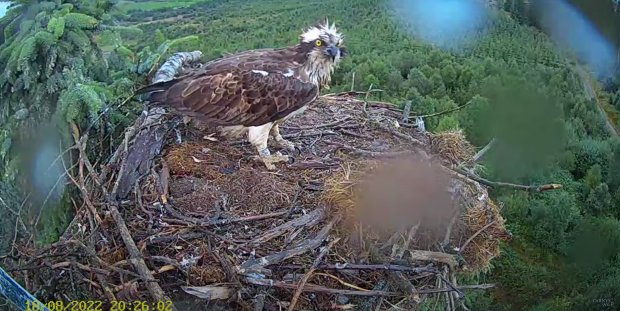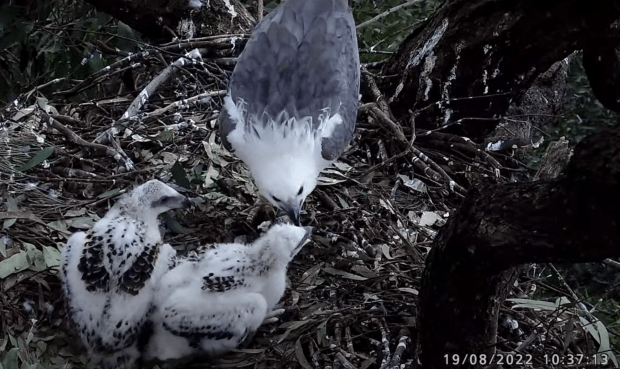3 August 2022
There is not a lot happening in Bird World right now other than some of the last ospreys leaving their nests in the UK, the just perfect fledge of the QT Chick off Taiaroa Head in New Zealand yesterday, and perhaps a season’s goodbye from Iris and Louis at Hellgate Canyon. Birds are flying and each of us has that ’empty nest’ syndrome. At the same time, there are a few Osprey dads in the UK that might wish their darling daughters were on their way!
I paid a visit to a couple of the local ponds yesterday afternoon. It was not so hot and many of the birds were quite active compared to what they had been in days prior.






The local Egrets fooled everyone last night choosing to stay at another roosting site and leaving photographers dismayed!
One flew over the pond. Noticed that no one else was on the roosting tree and took over for another pond about a kilometre away.

Meanwhile, I found one of the little ducklings – oh, the tiniest little things last week – in the water yesterday. There were originally two. I wonder if the other is hiding under the board walk. This one was out diving and eating. You can still see the downy fluff. It is also hard to tell from the image but the duckling is about 15 cm long or 6 inches.


In the evening, the geese were flying over in their perfect ‘V’. Did you know that the leader changes positions when it gets tired and moves to the back allowing another to take over while it rests at the back?

From the Book shelf:
The book stack is growing. I am so excited to introduce you to a wonderful wildlife photographer, Oliver Hellowell. Do you know him? Born with Down Syndrome, his mother was told that Oliver would never be able to accomplish anything. Thankfully, Oliver’s mother did not listen to the doctors and she created opportunities for him in sports, taught him sign language, gave him the gift of the love of reading. His Mum has worked tirelessly from the time Oliver had his first open heart surgeries, to find new ways for Oliver to communicate. She never gave up and her believe and the support circle that grew around this young man are inspirational in that they show us what ‘defying the odds’ really means. When he was 11, his stepfather put a camera in his hands ——-Oliver never looked back! The introduction of the camera changed Oliver’s life giving him a wonderful way of communicating with the world. Oliver is now 25.
Oliver’s book and a packet of cards arrived yesterday morning. It was a delight to see the postmark from the UK.
Oliver Hellowell’s book, Birds, is one of the nicest coffee table books I have handled. The cover and the paper are first-rate, the images are crystal clear and amazing. Oliver loves water and he often captures the finer water droplets on a shore birds beak or wing. Each bird is identified often with a comment by Oliver on what it was about that particular bird that interested him. He loves gulls and wrens!




Oliver has his own website where you can meet him and see his images of birds and the landscapes where he has traveled. There is also a ‘shop’ section. If you are looking for beautiful cards that fit in their envelopes, different from those on the racks at your local shop, check out the ones that Oliver has for purchase. I picked a landscape pack and have no regrets! Keep Oliver Hellowell in mind if you are looking for a special holiday or birthday gift for a birding friend.

You can find Oliver’s books and cards at his website and I have also included a BBC article about this very talented young man who is living his dream to be a wildlife photographer.
https://www.oliverhellowell.com/
https://www.bbc.com/news/av/magazine-29107894
Making News:
As more and more wildlife become extinct, researchers in Hawaii are working hard to keep the K’auai Creeper -who is predicted to go extinct because of mosquitoes carrying Avian Malaria – alive.


Nest News:
Stephen Basly continues to post the most wonderful images of Little Bit ND17 on the Notre Dame Eagles website. So grateful to him and all the birders on the ground who continued to chase after our adored Little Bit supplying us daily with information when he was near the nest territory. These images now are of course so welcome – fly high, Little Bit. Stay safe. Eat well.
These are just beautiful images. Thank you, Stephen!


One of these is going to be a magnet on my fridge. Several years ago, my Sea Eagle contact, suggested that magnets are a way of remembering those special birds. Of course, at the time, I swore that there would not be bird items all over my house…who was I fooling? The magnets are fantastic. I still say good morning to many including Legacy, Big Red, and others. Room will be made for Little Bit and Victor this year!
Checking the trackers from the north of Europe and Bonus is still in Belarus. No check in from the others. Salli, the Finnish Osprey, is in Ukraine. Some have suggested that the birds might be safer flying through a war zone than being shot over Malta and Lebanon deliberately. That person has a point.

At the Dyfi Nest of Idris and Telyn, Idris continues to deliver fish to his daughter, Padarn who joined the 100 day club today. What is the 100 day club? Well, normally, the mum and fledglings are all departed by 100 days leaving Dad to gather his strength for migration. But some of them – three in fact – have been slow to leave and have made the ‘Century Club’ at the Dyfi Nest. They are Berthyn in 2019 who stayed 101.4 days and Dysnni who stayed 100.1 days in 2021. Padarn looks pretty comfy with Dad bringing her good meals. Maybe she will stay the longest!

No signs of leaving in the late day. Idris can hear her fish calling down at the Dyfi River!



Aran is still chasing after the chicks and sometimes Mrs G, too, at the Glaslyn nest.



Dear Louis at the Loch Arkaig Osprey nest is still providing nice fish for Sarafina, too. I think Sarafina is a bit like Padarn – they love being the ‘only ones’ in Dad’s life!




That is it for Saturday. The Australian birds are still napping. Every nest seems to be fine – looking forward to hatch at Port Lincoln in 2 weeks…oh, let us hope the time does fly.
Thank you for joining me today. Please take care of yourself. See you soon!
Thank you to the following for their posts, videos, or streaming cams where I took my screen captures: Oliver Hellowell, The Birding Project, Notre Dame Eagles and Stephen Basly, Laji.Fi, Dyfi Osprey Project, Bywyd Gwylld Glaslyn, and Friends of Loch Arkaig and the Woodland Trust.







































































































































































































